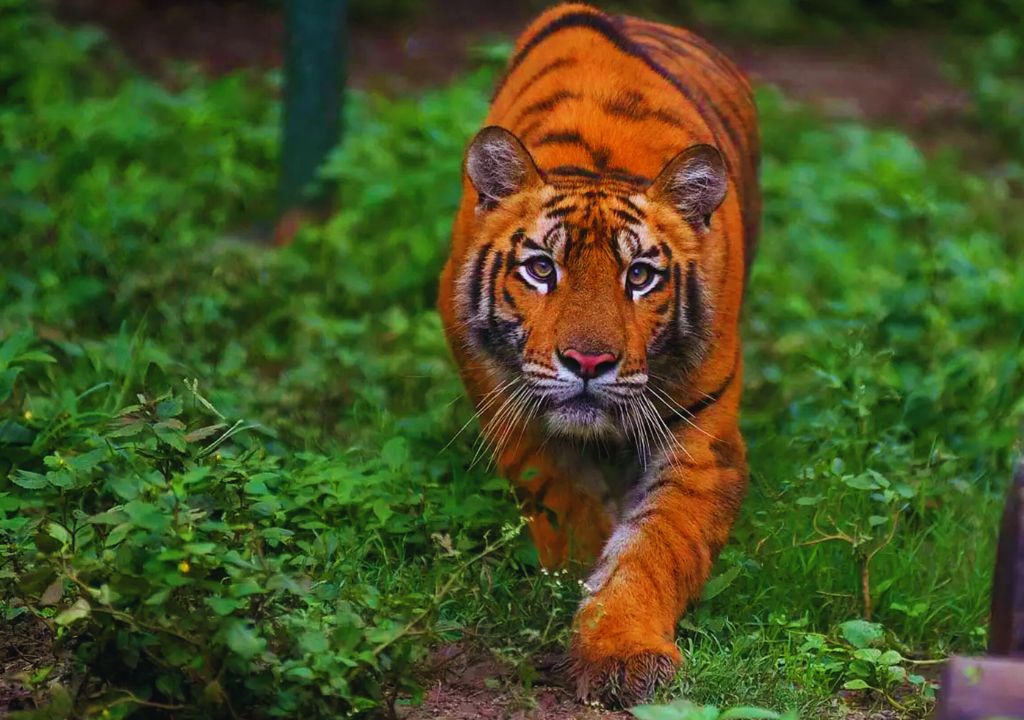Tigers, the iconic apex predators, hold a special place in the intricate web of life within Rajaji National Park. Nestled in the foothills of the Himalayas in northern India, this biodiverse haven is home to a thriving population of these majestic creatures. As we delve into the world of tigers in Rajaji National Park, we uncover a tale of historical significance, conservation successes, technological innovations, and the crucial role of communities in ensuring the survival of these magnificent beasts.
Currently, the Rajaji Tiger Reserve houses approximately 37 tigers, with a notable presence of two tigresses within its expansive western region, spanning 570 square kilometers. The outcomes of a recent survey conducted by the state forest department unveiled that the reserve possesses a carrying capacity that could potentially accommodate up to 83 tigers.

Historical Significance of Tigers in Rajaji
References to tigers in the Rajaji region date back centuries, with folklore and historical accounts recounting their presence. These magnificent felines have long been revered, inspiring respect and awe. However, as human activities intensified, so did the threat to their existence. Conservation efforts gained momentum during the 20th century, as the urgency to protect these endangered animals became apparent.
Tiger Habitats and Behavior
Rajaji National Park boasts an array of habitats, ranging from lush forests to grassy meadows and serene riverbanks. This diversity provides an ideal environment for tigers, allowing them to exhibit their intricate behaviors. Tigers, known for their solitary and nocturnal nature, often engage in strategic hunting patterns. The dense foliage and varied terrain of the park offer them the perfect stage for their stealthy pursuits.

Conservation Successes and Challenges
The relentless efforts of conservationists have yielded positive outcomes, with the tiger population in Rajaji National Park showing signs of growth. Strict anti-poaching measures, habitat restoration, and community involvement have played pivotal roles in this success story. However, the path to conservation is riddled with challenges. Human-wildlife conflict, driven by habitat encroachment and limited resources, poses a constant threat to both tigers and local communities.
Role of Ecotourism in Tiger Conservation
Sustainable ecotourism practices have emerged as a vital tool in tiger conservation. Responsible tourism not only generates economic benefits for local communities but also raises awareness about the importance of protecting these apex predators. Visitors, guided by knowledgeable naturalists, contribute to conservation efforts while experiencing the raw beauty of tigers in their natural habitat.

Technological Innovations in Tiger Monitoring
In the digital age, technology has revolutionized wildlife monitoring and protection. GPS tracking collars and strategically placed camera traps provide invaluable insights into tiger behavior and movement. This data-driven approach enables conservationists to make informed decisions, ensuring the long-term survival of tigers in the ever-changing landscape.
Community Involvement in Conservation
Local communities play a pivotal role in safeguarding tigers. Collaborative efforts between conservation organizations and villagers have led to innovative solutions that foster coexistence. Community-led initiatives, such as alternative livelihood programs and education campaigns, empower residents to become stewards of the land, diminishing the potential for conflicts with wildlife.

Collaborative Conservation Efforts
The protection of tigers transcends national boundaries. Government agencies, non-governmental organizations, and international partners collaborate to establish a united front against poaching and habitat degradation. Collective action, guided by shared goals, bolsters the chances of preserving these iconic animals for generations to come.
Future Prospects and Challenges
The journey of tiger conservation in Rajaji National Park continues. While significant strides have been made, the road ahead is fraught with challenges. As climate change threatens to alter habitats and disrupt ecosystems, adaptability, and resilience become imperative for the survival of tigers and their prey. Continued vigilance, scientific research, and sustained community engagement are vital to secure a future where tigers thrive.
Conclusion
Tigers in Rajaji National Park embody the delicate balance of nature’s grandeur and humanity’s responsibility. Their presence symbolizes the success of collaborative conservation efforts and the potential for harmonious coexistence between humans and wildlife. As we stand at the crossroads of conservation, we are entrusted with the solemn duty to protect these magnificent creatures, ensuring that their majestic roars echo through the valleys of Rajaji for generations to come.
FAQs about Tigers in Rajaji National Park:
1. Are tigers the only predators in Rajaji National Park?
Tigers are the apex predators, but the park is also home to leopards, jackals, and other carnivores.
2. How can tourists contribute to tiger conservation?
Responsible tourism, supporting eco-friendly lodges, and following park guidelines, directly benefits tiger conservation efforts.
3. What is the significance of the tiger’s role in the ecosystem?
Tigers play a crucial role in maintaining the balance of the ecosystem by regulating prey populations.
4. How do local communities participate in tiger conservation?
Local communities engage in various conservation initiatives, such as wildlife protection patrols and sustainable livelihood programs.
5. What is the current status of the tiger population in Rajaji National Park?
Thanks to dedicated conservation efforts, the tiger population in Rajaji National Park has shown a positive upward trend in recent years.
